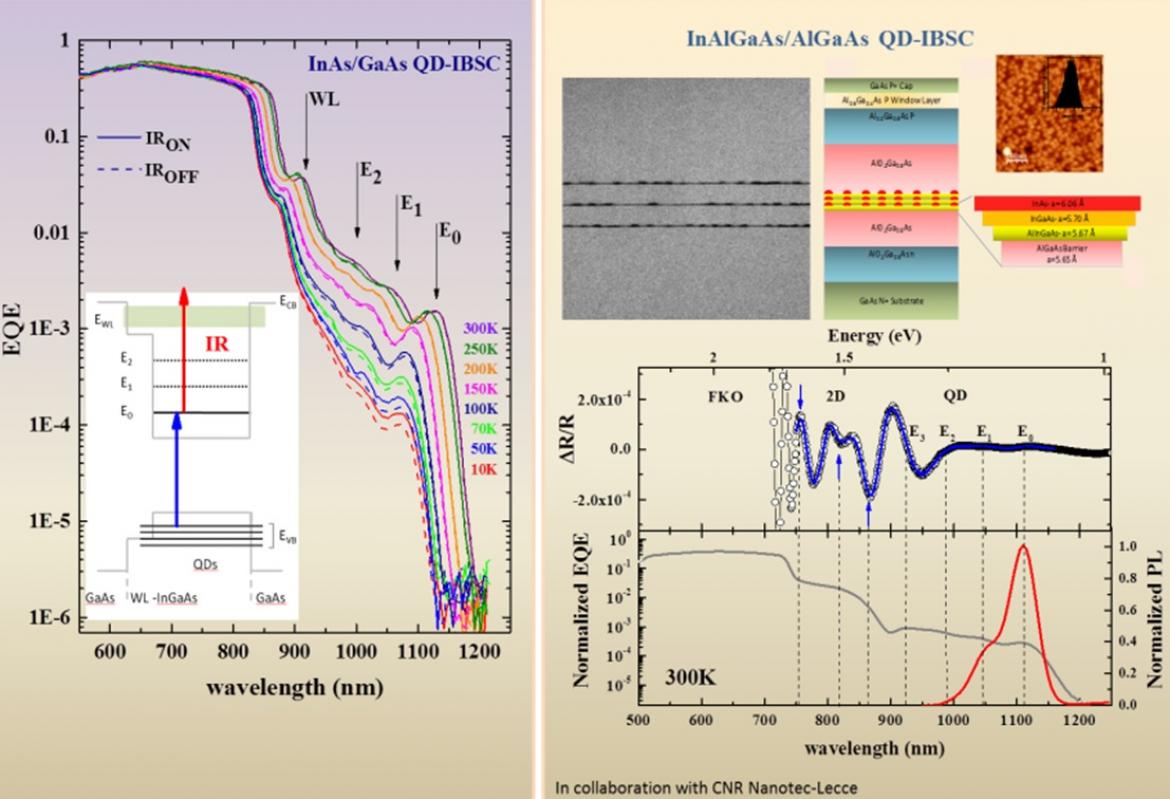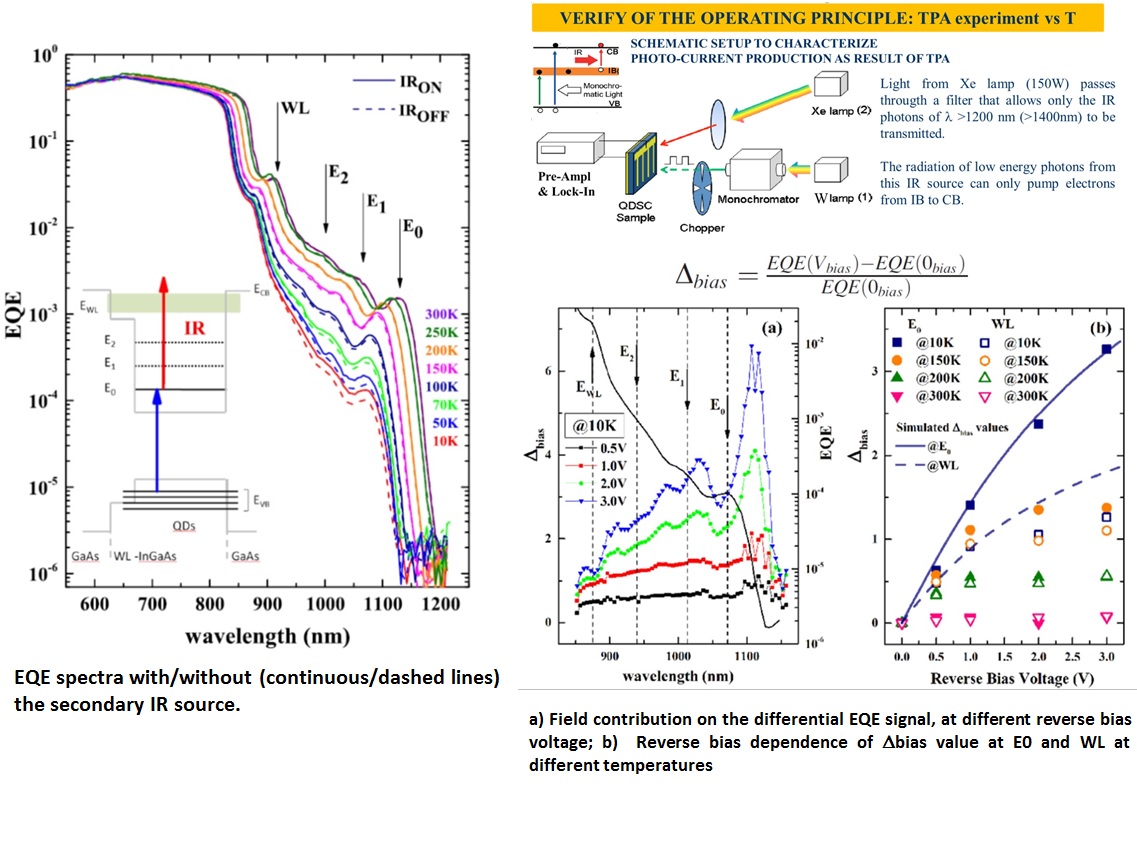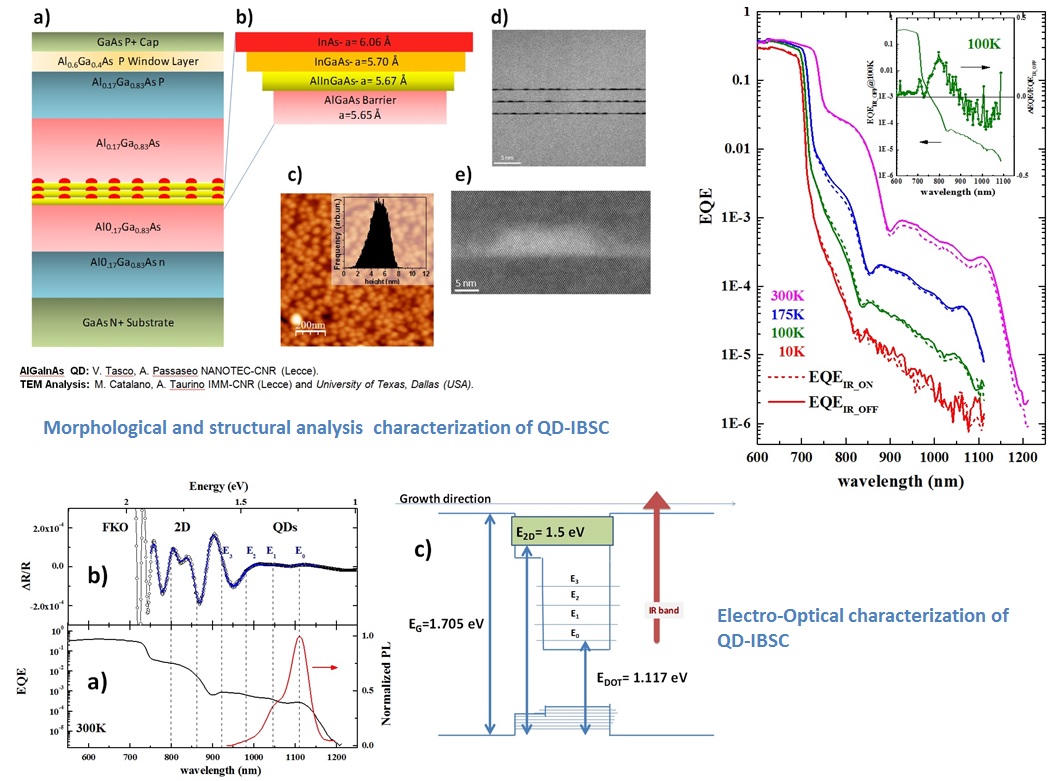
Intermediate Band Solar Cells (IBSC) are an innovative concept of photovoltaic system with a theoretically predicted increased efficiency with respect to the Schockley-Queisser limit of single junction solar cell, due to the expected high power conversion value (63.1% vs 40.7%). The idea of IBSC is motivated by the possibility to increase the efficiency of single gap SC by means of photon absorption below the band-gap energy (Two-Step Two Photon Absorption TS-TPA), inserting an Intermediate energy Band (IB) between Valence and Conduction Band (VB and CB), and preserving, at the same time, the output voltage. It deserves to be stressed that the key point for IBSC operation is to induce electron transitions between the involved energy bands only by photon absorption.
(A. Cretì, M. Lomascolo, A. Cola)
Activity in collaboration with NANOTEC-CNR, (Lecce), and National Nanotechnology Research Centre (Riyadh), Kingdom of Saudi Arabia.
A) Role of charge separation on two-step two photon absorption in InAs/GaAs quantum dot intermediate band solar cells
Despite of the high potentialities of this theory, its practical applications are limited by the materials which can be effectively employed to get the required band profile. The most studied system so far consists of InAs Quantum Dots (QDs) self organized in a GaAs matrix, a system limited by the dominance of carrier thermal escape induced by the related energy band profiling. A clear picture on the mutual competition between all the hole and electron carrier generation/escape mechanisms, which take place in these systems, and the TS-TPA is still missing.
In particular, the different role of holes and electrons is highlighted. Experiments of external quantum efficiency dependent on temperature and electrical or optical bias (two-step two photon absorption) highlight a relative increase as high as 38% at 10K under infrared excitation. We interpret these results on the base of charge separation by phonon assisted tunneling of holes from quantum dots, which, reducing the recombination rate and competing with the other escape processes, enhances the infrared absorption contribution.

A. Cretì, V, Tasco et al “Role of charge separation on two-step two photon absorption in InAs/GaAs quantum dot intermediate band solar cells” Appl. Phys. Lett. 108, 063901 (2016)
B) Quantum Dot Intermediate Band Solar Cells: Role of Al-based extended 2D states in photocarrier extraction and trapping
Further achievements within the IBSC concept are expected by the addition of Al both, in the GaAs barrier and in the InAs QD coverage. In particular we have investigated a solar cell structure where the concept of intermediate band is exploited by a high energy barrier AlGaAs material with embedded InAs quantum dots via a multistep growth approach. In this way the intrinsic issues related to different surface kinetics of involved species (Ga, In and Al adatoms) and affecting crystal quality are successfully overcome.
QDs grown in an AlGaAs matrix by means of multistep growth approach are employed for a solar cell device, demonstrating that hetero-structure defect density can be effectively controlled. The 2D Al-rich layer which has been exploited to control the strain field arising from the QDs is found to add a wide 2D energy band above the QD states. The resulting energy band diagram has been depicted by converging the results of several electro-optical spectroscopic characterizations (PR, PL, EQE). The 2D structure resulted to be strongly related with the QD states by carrier thermal transferring and inter-level filling processes. In particular, these 2D states exhibit larger bandwidth with respect to common WL and at higher energy, and allow a strong increment of PC via two step two photon absorption in the related spectral region, up to 100K. Therefore, further engineering on such a state and on its relationship with 3D confined QD states represents a promising way to extend IBSC design flexibility and to improve their efficiency.

TEM Analysis: A. Taurino and M. Catalano IMM-CNR Lecce and University of Texas Dallas (USA)
Activity in collaboration with NANOTEC-CNR Lecce (V. Tasco and A. Passaseo)
V. Tasco, A. Cretì et al “Mechanisms of Photocurrent Generation in Large Band-Gap Quantum Dot Solar Cell realized via a Multistep Growth” to be published.


